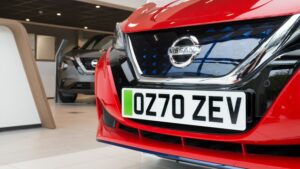Everything you need to know about green number plates
As the world shifts towards more sustainable transportation solutions, introducing green number plates in the UK marks a significant milestone in promoting zero-emission vehicles.
These distinctive plates, featuring a green stripe on the number plate, symbolise environmental responsibility and have various benefits and incentives. In this guide, we explore everything you need to know about green number plates, from their history and benefits to the types of vehicles eligible and the process of getting one.
Whether you’re curious about the initiative or considering an electric vehicle, this article will provide all the essential information.

What are green number plates?
Green number plates are a recent innovation in the UK. They were introduced to identify and promote environmentally friendly vehicles. These plates feature a green stripe on the left-hand side, making them easily distinguishable from standard number plates.
But why do some number plates have a green stripe? The primary purpose is to highlight zero-emission vehicles, contributing to broader efforts to reduce carbon emissions and combat climate change.
Green number plates make it easy for the public and authorities to recognise vehicles contributing to cleaner air and a healthier environment. This initiative is part of the UK government’s strategy to promote electric vehicles (EVs) and support the transition to a more sustainable transportation system.
The history of green number plates
The concept of green number plates was first proposed by the UK government in 2019 as part of its Road to Zero strategy. This strategy aims to make the UK a world leader in zero-emission vehicle adoption, with an ambitious target to end the sale of new petrol and diesel cars and vans by 2030.
Following a public consultation, the Department for Transport (DfT) and the Driver and Vehicle Licensing Agency (DVLA) announced the introduction of DVLA green number plates in 2020. The plates became available on 8 December 2020, marking a significant step in the government’s efforts to encourage the adoption of zero-emission vehicles.
Similar schemes inspired the introducing of green number plates in other countries, such as Canada and Norway, where special plates for environmentally friendly vehicles have been used significantly. These initiatives have helped raise awareness about sustainable transport and incentivised using zero-emission vehicles through various benefits and perks.
The benefits of green number plates
Green number plates offer several benefits, both for vehicle owners and society as a whole. These benefits are designed to encourage the adoption of zero-emission vehicles and support the transition to a more sustainable transportation system.
Increased awareness
Green number plates help raise public awareness about the importance of zero-emission vehicles and their role in reducing carbon emissions. By making these vehicles more visible on the roads, the plates serve as a constant reminder of the need for sustainable transport solutions.
Incentives and perks
Vehicles with green number plates may be eligible for various incentives and perks, such as reduced parking fees, access to low-emission zones, and exemptions from congestion charges. These benefits offset the initial cost of purchasing an electric vehicle and make them more attractive to potential buyers.
Positive public image
Owners of vehicles with green number plates can enjoy a positive public image as they contribute to environmental protection and the transition to a greener future. This positive perception can be particularly valuable for businesses that want to showcase their commitment to sustainability.
Government support
The introduction of green number plates is part of the broader efforts by the UK government to support the adoption of zero-emission vehicles. This support includes financial incentives, investments in charging infrastructure, and research and development funding to advance electric vehicle technology.
Can only electric cars have green number plates?
A common question is whether electric cars can only have green number plates. While electric cars are the most common vehicle to feature green number plates, they are not the only ones eligible.
The critical criterion for a vehicle to have a green number plate is to produce zero tailpipe emissions.
This means that other types of zero-emission vehicles, such as hydrogen fuel cell vehicles and certain electric motorcycles, can also have green number plates. The focus is on the vehicle’s environmental impact rather than its specific technology.
Green number plates promote vehicles that reduce air pollution and carbon emissions. By extending this initiative to all zero-emission vehicles, the UK government encourages the adoption of a wide range of sustainable transport solutions.

Which types of vehicles have green number plates?
Green number plates are available for a specific category of vehicles: zero-emission vehicles. These vehicles produce no tailpipe emissions, making them essential to efforts to reduce air pollution and combat climate change.
The main types of vehicles eligible for green number plates include:
Battery electric vehicles (BEVs)
Battery electric vehicles (BEVs) are fully electric vehicles that run on electricity stored in batteries. They produce zero tailpipe emissions and are the most common vehicle eligible for green number plates. Examples of BEVs include the Tesla Model 3, Nissan Leaf, and Hyundai Kona Electric.
A common question is, do electric cars have to have green number plates? While it’s not mandatory, having green number plates can offer various benefits and incentives for BEV owners.
Battery electric vehicles (BEVs)
Battery electric vehicles (BEVs) are fully electric vehicles that run on electricity stored in batteries. They produce zero tailpipe emissions and are the most common vehicle eligible for green number plates. Examples of BEVs include the Tesla Model 3, Nissan Leaf, and Hyundai Kona Electric.
Hydrogen fuel cell vehicles (FCEVs)
FCEVs use hydrogen to generate electricity through a fuel cell, producing only water vapour as a byproduct. These vehicles also produce zero tailpipe emissions and are eligible for green number plates. Examples of FCEVs include the Toyota Mirai and Hyundai Nexo.
Other zero-emission vehicles
In addition to BEVs and FCEVs, other types of zero-emission vehicles may also be eligible for green number plates. These include electric motorcycles, buses, and trucks, as long as they produce no tailpipe emissions.
It’s important to note that hybrid vehicles, which combine an internal combustion engine with an electric motor, are not eligible for green number plates. This is because they still produce tailpipe emissions, even if they are significantly lower than traditional petrol or diesel vehicles.
How to get a green number plate
The process is straightforward if you own a zero-emission vehicle and want a green number plate. Here are the steps you need to follow:
Check eligibility
Before applying for a green number plate, ensure your vehicle is eligible. As mentioned, only zero-emission vehicles, such as battery electric vehicles and hydrogen fuel cell vehicles, qualify for green number plates. You can check with the DVLA or manufacturer to clarify your vehicle’s eligibility.
Choose a registered number plate supplier
Green number plates must be purchased from a registered number plate supplier, such as Number1Plates. The DVLA authorises these suppliers to produce number plates that meet the required standards and specifications. You can find a list of registered number plate suppliers on the DVLA website.
Provide the necessary documentation
When purchasing a green number plate, you must provide proof of your vehicle’s eligibility. This typically includes the vehicle’s registration certificate (V5C) and other relevant documentation confirming its zero-emission status. The supplier will use this information to verify your eligibility and produce the appropriate number plate.
Order your green number plate
Once your eligibility has been confirmed, you can order your green number plate. Here at Number1Plates, we will create the plate according to the required specifications, including the green stripe on the left-hand side. We aim to dispatch all our orders within 24 hours of you purchasing your plate.
Fit the green number plate to your vehicle
After receiving your green number plate, you’ll need to fit it to your vehicle. This process is similar to fitting a standard number plate and can be done at home or by a professional. Ensure the plate is securely attached and clearly visible, as required by law.
Update your vehicle records
Once your green number plate is fitted, update your vehicle records with the DVLA to reflect the change. This ensures that your vehicle’s registration details are accurate and up-to-date. You can do this online through the DVLA website or by contacting the DVLA directly.
By following these steps, you can easily obtain a green number plate for your zero-emission vehicle, helping to promote sustainable transport and contribute to a cleaner, greener future.
Whether you own a battery electric vehicle, a hydrogen fuel cell vehicle, or another type of zero-emission vehicle, getting a green number plate is a simple process that can offer numerous benefits for you and the environment.




 100% Road Legal
100% Road Legal Express Delivery
Express Delivery


